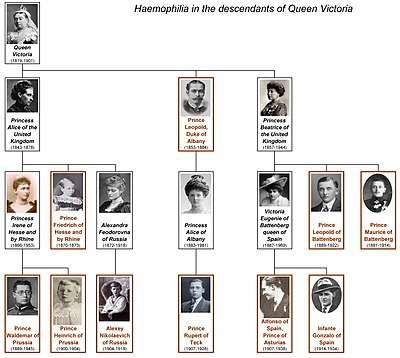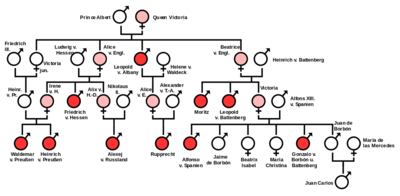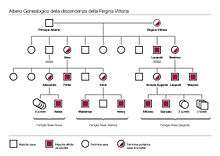Haemophilia in European royalty
Haemophilia figured prominently in the history of European royalty in the 19th and 20th centuries. Britain's Queen Victoria, through two of her five daughters, Princess Alice and Princess Beatrice, passed the mutation to various royal houses across the continent, including the royal families of Spain, Germany and Russia. Victoria's son Prince Leopold, Duke of Albany, also suffered from the disease. For this reason, haemophilia was once popularly called "the royal disease". Tests on the remains of the Romanov imperial family show that the specific form of haemophilia passed down by Queen Victoria was probably the relatively rare Haemophilia B.[1]


The sex-linked X chromosome disorder manifests almost exclusively in males, even though the genetic mutation causing the disorder is located on the X chromosome and can be inherited from the mother by male children or from either mother or father by female children. This is because the trait is recessive, meaning that only one correctly-functioning copy of the blood clotting factor gene is necessary for normal clotting. Females have two X chromosomes, and hence redundant copies of the blood clotting factor gene located on them. A female who inherits a mutated copy on one X chromosome has also inherited a second X chromosome from the other parent that is likely to carry a non-mutated copy of the gene, capable of directing appropriate clotting. Such a female, with normal clotting but possessing a single mutated copy of the gene, is called a carrier. Males only possess a single X chromosome, inherited from their mother, having received a Y chromosome from their father instead of a second X. If their sole X chromosome contains the haemophilia mutation they possess no second copy to provide for normal function, as in carrier females. Each child of a carrier will have a 50% chance of inheriting their mother's mutation, of being a haemophiliac (sons) or carrier (daughters). The daughter of a male haemophiliac will always inherit his mutation, while a son cannot ever inherit it. A female will only be affected with haemophilia in the rare circumstance that she inherits mutated X chromosomes from both a haemophiliac father and a carrier mother. No case of such double inheritance is known among Queen Victoria's descendants.
Although an individual's haemophilia can usually be traced in the ancestry, in about 30% of cases there is no family history of the disorder, and the condition is speculated to be the result of spontaneous mutation in an ancestor.[2] Victoria's appears to have been a spontaneous or de novo mutation and she is usually considered the source of the disease in modern cases of haemophilia among her descendants. Queen Victoria's father, Prince Edward, Duke of Kent, was not a haemophiliac, and the probability of her mother having had a lover who suffered from haemophilia is minuscule given the low life expectancy of 19th-century haemophiliacs. Her mother, Victoria, Duchess of Kent, was not known to have a family history of the disease, although it is possible that she was a carrier, but among her children only Victoria received the mutated copy. The rate of spontaneous mutation is known to increase with paternal age, and Victoria's father was 51 at her birth.
Queen Victoria's eldest daughter, Victoria, Princess Royal, apparently escaped the haemophilia gene as it did not appear in any of her matrilineal descendants. Victoria's fifth child, Helena, may or may not have been a carrier; two healthy sons survived to adulthood, but two other sons died in infancy and her two daughters did not have issue. Victoria's sixth child, Louise, died without issue. Queen Victoria's sons Edward, Alfred, and Arthur were not haemophiliacs; however, her daughters Alice and Beatrice were confirmed carriers of the gene, and Victoria's son Leopold was a sufferer of haemophilia, making his daughter Princess Alice, Countess of Athlone a carrier as well.
Queen Victoria family tree
Children
Victoria, German Empress (1840–1901) Issue: Wilhelm II of Germany, Charlotte, Duchess of Saxe-Meiningen, Prince Henry of Prussia, Prince Sigismund of Prussia, Viktoria, Princess Adolf of Schaumburg-Lippe, Prince Waldemar of Prussia, Sophia, Queen of the Hellenes, Margaret, Landgravine of Hesse-Kassel
Edward VII, King of the United Kingdom (1841–1910) Issue: Prince Albert Victor, Duke of Clarence and Avondale, George V, Louise, Princess Royal, Princess Victoria, Maud, Queen of Norway, Prince Alexander John
Princess Alice, Grand Duchess of Hesse and by Rhine (1843–1878) Issue: Victoria Mountbatten, Marchioness of Milford Haven, Grand Duchess Elizabeth Feodorovna of Russia, Irene, Princess Henry of Prussia, Ernest Louis, Grand Duke of Hesse and by Rhine, Prince Friedrich, Alexandra Feodorovna, Empress of Russia, Princess Marie of Hesse and by Rhine
Prince Alfred, Duke of Saxe-Coburg and Gotha (1844–1900) Issue: Alfred, Hereditary Prince of Saxe-Coburg and Gotha, Marie, Queen of Romania, Victoria Melita, Grand Duchess of Russia, Alexandra, Princess of Hohenlohe-Langenburg, Princess Beatrice, Duchess of Galliera
Helena, Princess Christian of Schleswig-Holstein (1846–1923) Issue: Prince Christian Victor, Albert, Duke of Schleswig-Holstein, Princess Helena Victoria, Princess Marie Louise, Prince Harald
Princess Louise, Duchess of Argyll (1848–1939) No issue
Prince Arthur, Duke of Connaught and Strathearn (1850–1942) Issue: Margaret, Crown Princess of Sweden, Prince Arthur of Connaught, Princess Patricia, Lady Ramsay
Prince Leopold, Duke of Albany (1853–1884) Issue: Princess Alice, Countess of Athlone, Charles Edward, Duke of Saxe-Coburg and Gotha
Beatrice, Princess Henry of Battenberg (1857–1944) Issue: Alexander Mountbatten, 1st Marquess of Carisbrooke, Victoria Eugenie, Queen of Spain, Lord Leopold Mountbatten, Prince Maurice of Battenberg
Haemophilia in European royalty | |||||||||||||||||||||||||||||||||||||||||||||||||||||||||||||||||||||||||||||||||||||||||||||||||||||||||||||||||||||||||||||||||||||||||||||||||||||||||||||||||||||||||||||||||||||||||||||||||||||||||||||||||||||||||||||||||||||||||||||||||||||||||||||||||||||||||||||||||||||||||||||||||||||||||||||||||||||||||||||||||||||||||||||||||||||||||||||||||||||||||||||||||||||||||||||||||||||||||||||||||||||||||||||||||||||||||||||||||||||||||||||||||||||||||||||||||||||||||||||||||||||||||||||||||||||||||||||||||||||||||||||||||||||||||||||||||||||||||||||||||||||||||||||||||||||||||||||||||||||||||||||||||||||||||||||||||||||||||||||||||||||||||||||||||||||||||||||||||||||||||||||||||||||||||||||||||||||||||||||||||||||||||||||||||||||||||||||||||||||||||||||||||||||||||||||||||||||||||||||||||||||||||||||||||||||||||||||||||||||||||||||||||||||||||||||||||||||||||||||||||||||||||||||||||||||||||||||||||||||||||||||||||||||||||||||||||||||||||||||||||||||||||||||||||||||||||||||||||||||||
|---|---|---|---|---|---|---|---|---|---|---|---|---|---|---|---|---|---|---|---|---|---|---|---|---|---|---|---|---|---|---|---|---|---|---|---|---|---|---|---|---|---|---|---|---|---|---|---|---|---|---|---|---|---|---|---|---|---|---|---|---|---|---|---|---|---|---|---|---|---|---|---|---|---|---|---|---|---|---|---|---|---|---|---|---|---|---|---|---|---|---|---|---|---|---|---|---|---|---|---|---|---|---|---|---|---|---|---|---|---|---|---|---|---|---|---|---|---|---|---|---|---|---|---|---|---|---|---|---|---|---|---|---|---|---|---|---|---|---|---|---|---|---|---|---|---|---|---|---|---|---|---|---|---|---|---|---|---|---|---|---|---|---|---|---|---|---|---|---|---|---|---|---|---|---|---|---|---|---|---|---|---|---|---|---|---|---|---|---|---|---|---|---|---|---|---|---|---|---|---|---|---|---|---|---|---|---|---|---|---|---|---|---|---|---|---|---|---|---|---|---|---|---|---|---|---|---|---|---|---|---|---|---|---|---|---|---|---|---|---|---|---|---|---|---|---|---|---|---|---|---|---|---|---|---|---|---|---|---|---|---|---|---|---|---|---|---|---|---|---|---|---|---|---|---|---|---|---|---|---|---|---|---|---|---|---|---|---|---|---|---|---|---|---|---|---|---|---|---|---|---|---|---|---|---|---|---|---|---|---|---|---|---|---|---|---|---|---|---|---|---|---|---|---|---|---|---|---|---|---|---|---|---|---|---|---|---|---|---|---|---|---|---|---|---|---|---|---|---|---|---|---|---|---|---|---|---|---|---|---|---|---|---|---|---|---|---|---|---|---|---|---|---|---|---|---|---|---|---|---|---|---|---|---|---|---|---|---|---|---|---|---|---|---|---|---|---|---|---|---|---|---|---|---|---|---|---|---|---|---|---|---|---|---|---|---|---|---|---|---|---|---|---|---|---|---|---|---|---|---|---|---|---|---|---|---|---|---|---|---|---|---|---|---|---|---|---|---|---|---|---|---|---|---|---|---|---|---|---|---|---|---|---|---|---|---|---|---|---|---|---|---|---|---|---|---|---|---|---|---|---|---|---|---|---|---|---|---|---|---|---|---|---|---|---|---|---|---|---|---|---|---|---|---|---|---|---|---|---|---|---|---|---|---|---|---|---|---|---|---|---|---|---|---|---|---|---|---|---|---|---|---|---|---|---|---|---|---|---|---|---|---|---|---|---|---|---|---|---|---|---|---|---|---|---|---|---|---|---|---|---|---|---|---|---|---|---|---|---|---|---|---|---|---|---|---|---|---|---|---|---|---|---|---|---|---|---|---|---|---|---|---|---|---|---|---|---|---|---|---|---|---|---|---|---|---|---|---|---|---|---|---|---|---|---|---|---|---|---|---|---|---|---|---|---|---|---|---|---|---|---|---|---|---|---|---|---|---|---|---|---|---|---|---|---|---|---|---|---|---|---|---|---|---|---|---|---|---|---|---|---|---|---|---|---|---|---|---|---|---|---|---|---|---|---|---|---|---|---|---|---|---|---|---|---|---|---|---|---|---|---|---|---|---|---|---|---|---|---|---|---|---|---|---|---|---|---|---|---|---|---|---|---|---|---|---|---|---|---|---|---|---|---|---|---|---|---|---|---|---|---|---|---|---|---|---|---|---|---|---|---|---|---|---|---|---|---|---|---|---|---|---|---|---|---|---|---|---|---|---|---|---|---|---|---|---|---|---|---|---|---|---|---|---|---|---|---|---|---|---|---|---|---|---|---|---|---|---|---|---|---|---|---|---|---|---|---|---|---|---|---|---|---|---|---|---|---|---|---|---|---|---|---|---|---|---|---|---|---|---|---|---|---|---|---|---|---|---|---|---|---|---|---|---|---|---|---|---|---|---|---|---|---|---|---|---|---|---|---|---|---|---|---|---|---|---|---|---|---|---|---|---|---|---|---|---|---|---|---|---|---|---|---|---|---|---|---|---|---|---|---|---|---|---|---|---|---|---|---|---|---|---|---|---|---|---|---|---|---|---|---|---|---|---|---|---|---|---|---|---|---|---|---|---|---|---|---|---|---|---|---|---|---|---|---|---|---|---|---|---|---|---|---|---|---|---|---|---|---|---|---|---|---|---|---|---|---|---|---|---|---|---|---|---|---|---|---|---|---|---|---|---|---|---|---|---|---|---|---|---|---|---|---|---|---|---|---|---|---|---|---|---|---|---|---|---|---|---|---|---|---|---|---|---|---|---|---|---|---|---|
Legend: X – unaffected X chromosome; x – affected X chromosome; Y – Y chromosome Source: Aronova-Tiuntseva, Yelena; Herreid, Clyde Freeman (20 September 2003). "Hemophilia: 'The Royal Disease'" (PDF). SciLinks. National Science Teachers Association. p. 7. Archived from the original (PDF) on 10 January 2018. | |||||||||||||||||||||||||||||||||||||||||||||||||||||||||||||||||||||||||||||||||||||||||||||||||||||||||||||||||||||||||||||||||||||||||||||||||||||||||||||||||||||||||||||||||||||||||||||||||||||||||||||||||||||||||||||||||||||||||||||||||||||||||||||||||||||||||||||||||||||||||||||||||||||||||||||||||||||||||||||||||||||||||||||||||||||||||||||||||||||||||||||||||||||||||||||||||||||||||||||||||||||||||||||||||||||||||||||||||||||||||||||||||||||||||||||||||||||||||||||||||||||||||||||||||||||||||||||||||||||||||||||||||||||||||||||||||||||||||||||||||||||||||||||||||||||||||||||||||||||||||||||||||||||||||||||||||||||||||||||||||||||||||||||||||||||||||||||||||||||||||||||||||||||||||||||||||||||||||||||||||||||||||||||||||||||||||||||||||||||||||||||||||||||||||||||||||||||||||||||||||||||||||||||||||||||||||||||||||||||||||||||||||||||||||||||||||||||||||||||||||||||||||||||||||||||||||||||||||||||||||||||||||||||||||||||||||||||||||||||||||||||||||||||||||||||||||||||||||||||||
Princess Alice
Alice (1843–1878), Victoria's third child, and wife of the future Grand Duke Louis IV of Hesse and by Rhine (1837–1892), passed it on to at least three of her children: Irene, Friedrich, and Alix.
- Princess Victoria of Hesse and by Rhine (1863–1950), later Marchioness of Milford Haven, wife of Prince Louis of Battenberg (1854–1921) and maternal grandmother to Prince Philip, Duke of Edinburgh, apparently was not a carrier.
- Princess Elizabeth of Hesse and by Rhine (1864–1918), later Grand Duchess Elizabeth Feodorovna of Russia through her marriage to Grand Duke Sergei Alexandrovich (1857–1905), may or may not have been a carrier. Following her husband's assassination, she became a nun and was childless when killed by the Bolsheviks in 1918.
- Princess Irene of Hesse and by Rhine (1866–1953), later Princess Heinrich of Prussia, through her marriage to Prince Heinrich of Prussia (1862–1929), passed it on to two of her three sons:
- Prince Waldemar of Prussia (1889–1945). Survived to age 56; had no issue.
- Prince Heinrich of Prussia (1900–1904). Died at age 4.
- Prince Friedrich of Hesse and by Rhine (1870–1873). Died before his third birthday of bleeding on the brain resulting from a fall from a third-story window (which would almost certainly have been fatal even if he had not had haemophilia).
- Princess Alix of Hesse and by Rhine (1872–1918), later Empress Alexandra Feodorovna of Russia through her marriage to Tsar Nicholas II (1868–1918). Alix had a marriage proposal from her first cousin, Prince Albert Victor (1864–1892), eldest son of the then Prince of Wales (later King Edward VII); had she accepted, haemophilia could have returned to the direct line of succession in Britain.
- Grand Duchess Maria (1899–1918), Nicholas and Alexandra's third daughter, was thought by some to have been a symptomatic carrier because she haemorrhaged during a tonsillectomy.[3] DNA testing of the Romanov family remains in 2009 showed that one of the four daughters, thought to be Maria by American researchers and Anastasia by Russian researchers, was a carrier.[1]
- Tsarevitch Alexei (1904–1918) was murdered with his family by the Bolsheviks at the age of 13. Alexei's haemophilia was one of the factors contributing to the collapse of Imperial Russia during the Russian Revolution of 1917.[4]
- Princess Marie of Hesse and by Rhine (1874–1878), Alice's seventh and last child, may or may not have been a carrier. She died of diphtheria at the age of four.
Prince Leopold
Leopold (1853–1884), Victoria's eighth child, was the first member of the family to manifest haemophilia; he died at age 30 from bleeding after a minor fall,[5] only two years after marrying Princess Helena of Waldeck and Pyrmont. (1861–1922)
He passed the gene on to his only daughter, as all of the daughters of a haemophiliac father would inherit the gene:
- Princess Alice of Albany (1883–1981), later Countess of Athlone, who in turn passed it on to her elder son:
- Prince Rupert of Teck (1907–1928), who died at age 20, bleeding to death after a car accident.
Alice's younger son Prince Maurice of Teck died in infancy, so it is not known if he was a sufferer. Her daughter Lady May Abel Smith (1906–1994), Leopold's granddaughter, has living descendants none of whom has been known to have or to transmit haemophilia.
Leopold's posthumous son, Charles Edward (1884–1954), was unaffected, as a father cannot pass the gene to a son.
Princess Beatrice
Beatrice (1857–1944), Victoria's ninth and last child, and wife of Prince Henry of Battenberg (1858–1896) passed it on to at least two, if not three, of her four children:
- Princess Victoria Eugenie of Battenberg (1887–1969), later Queen Victoria Eugenia of Spain through her marriage to King Alfonso XIII (1886–1940), who passed it on to
- Infante Alfonso of Spain, Prince of Asturias (1907–1938). Died at age 31, bleeding to death after a car accident.
- Infante Gonzalo (1914–1934). Died at age 19, bleeding to death after a car accident.
- Victoria Eugenie's two daughters, Infantas Beatriz (1909–2002) and Maria Cristina of Spain (1911–1996), both have living descendants none of whom has been known to have or to transmit haemophilia.
- Prince Leopold of Battenberg (1889–1922), later, Lord Leopold Mountbatten. Died at age 32 during a knee operation.
- Prince Maurice of Battenberg (1891–1914). Killed in action in World War I at the age of 23. Maurice's haemophilia is disputed by various sources: It seems unlikely that a known haemophiliac would be allowed to serve in combat.
Today

No living member of the present or past reigning dynasties of Europe is known to have symptoms of haemophilia or is believed to carry the gene for it. The last descendant of Victoria known to suffer from the disease was Infante Don Gonzalo, born in 1914, although dozens of descendants of Queen Victoria's (including males descended only through females) have been born since 1914. However, because the haemophilia gene usually remains hidden in females who only inherit the gene from one parent, and female descendants of Victoria have left many descendants in royal and noble families, there remains a small chance that the disease could appear again, especially among the female-line Spanish descendants of Princess Beatrice.
Chronological order
Queen Victoria died in 1901 and lived to see her youngest son and a grandson die from the disease. The gene can be passed down the female line without a haemophiliac son being born, but as the family line continues and no haemophiliac sons are born, it becomes less likely that a certain ancestor had the gene and passed it on through the female line.
| # | Name | Death | Relation to Queen Victoria |
|---|---|---|---|
| 1 | Prince Friedrich of Hesse and by Rhine | 29-May-1873 | grandson |
| 2 | The Prince Leopold, Duke of Albany | 28-Mar-1884 | son |
| 3 | Prince Heinrich Friedrich of Prussia | 26-Feb-1904 | great grandson |
| 4 | Lord Leopold Mountbatten | 23-Apr-1922 | grandson |
| 5 | Prince Rupert of Teck | 15-Apr-1928 | great grandson |
| 6 | Infante Gonzalo of Spain | 13-Aug-1934 | great grandson |
| 7 | Alfonso, Prince of Asturias | 6-Sep-1938 | great grandson |
| 8 | Prince Waldemar of Prussia | 2-May-1945 | great grandson |
Type of haemophilia discovered
Because the last known descendant of Queen Victoria with haemophilia died in the 1940s, the exact type of haemophilia found in this family remained unknown until 2009. Using genetic analysis of the remains of the assassinated Romanov dynasty, and specifically Tsarevich Alexei, Rogaev et al. were able to determine that the "Royal Disease" is actually haemophilia B. Specifically, they found a single-nucleotide change in the gene for clotting Factor IX that causes incorrect RNA splicing and produces a truncated, nonfunctional protein.[6]
Notes
- "Case Closed: Famous Royals Suffered from Hemophilia". Archived April 12, 2010, at the Wayback Machine Michael Price, ScienceNOW, October 9, 2009.
- "Hemophilia B". Retrieved 2007-11-21.
- Ian Vorres, The Last Grand Duchess, 1965 p. 115.
- Massey, Nicholas and Alexandra, 1967
- Aronova-Tiuntseva, Yelena; Clyde Freeman Herreid (2003). "Hemophilia: "The Royal Disease"" (PDF). Science Cases: 1–7. Retrieved 23 March 2013.
- Rogaev EI, Grigorenko AP, Faskhutdinova G, Kittler EL, Moliaka YK (November 2009). "Genotype analysis identifies the cause of the "royal disease"". Science. 326 (5954): 817. Bibcode:2009Sci...326..817R. doi:10.1126/science.1180660. PMID 19815722.
References and external links
- Potts, D. M. Queen Victoria's Gene. Sutton Publishing, 1999. ISBN 0-7509-1199-9.
- "Hemophilia: The Royal Disease"
- Family tree of Queen Victoria and her descendants
- Haemophilia in Queen Victoria's Descendants. Archived 2006-11-18 at the Wayback Machine